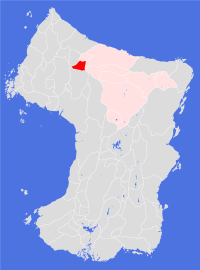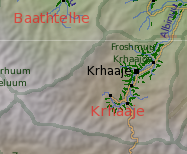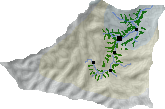Krhaaje

Societal ties: Ambostak
Current population: 1
Main language(s): Ramajal
Area: 58,000km²
Natural and political borders
Krhaaje is mountainous, in a place where the Souvjarhuum Bathtelizhuum and the Soufwhuu Viejizhuu run into each other; northern outcrops of these ranges mark the eastern and western borders of the Land.
The northern border is marked on the Albinuu river, at latitude 40.1°N - coincidentally this is the lowest point in the Land, at 730m.
History
The Plantation takes its name from a story dating back to the semi-mythical Bartak Empire that ruled all of Cheidrah, said to have collapsed some three millennia ago. The story tells of a land called The Krhaa hidden away in a high, twisting valley, whose kings were the guardians of great secrets; and how Maesi Bartuu, the first Emperor, traveled to the other side of the world to steal these secrets for the good of humanity. Like many Bartak stories, this fable has long been a favourite childhood tale. The first explorers to reach the upper Albinuu river named it Krhaaje, possibly in jest, though the place is evocative of some of the descriptions offered in various versions of the story.
The colonisation of the valley was sponsored by the temple authorities in the gt650s as part of its scientific and cultural expansion. Kraaje was planned as an artistic centre of excellence, a retreat where art and culture could be debated and developed for the greater good of the Ramane State. Work on developing the plantation was slow, principally because of the need to terrace large areas of the valley before cultivation could begin. The settlement was deliberately kept smaller than other settlements and, when it opened in gt661, immigration was strictly controlled by the temple on an invitation-only basis.
From the start, relationships between the immigrants and the temple were fractious. In particular, settlers argued against the principle of dividing culture and art from science and politics, and also against the limitations of the immigration policy. By gt675 they had won the argument and the settlement began an extensive programme to extend the cultivation upriver, made easier by the productivity of the soil once it had been cultivated. In gt677 the designs of a city were laid out at the upper limit of the northern scrublands habitat, which by gt700 boasted a population of over 15,000.
Growth of the plantation continued steadily throughout much of the eighth century and by gt740 the cultivation terraces had reached the city. By gt770 new strains of crops capable of surviving in the northern foothills habitat allowed the cultivation to continue upriver, with a second settlement established south of the city in gt789.
From the outset, the Krhaaje settlement had been granted a good deal of autonomy from the Ramane State, though it was still expected to contribute to the army and temple activities elsewhere. Because so many of the settlers were involved in extending the plantation this contribution tended to be in the form of monetary contributions rather than in manpower. Similarly, the army had little presence on the plantation as much of their activity was focussed further east. When the diamond crisis came in the gt790s Krhaaje chose to support the southern rebels rather than the state, which by this time was viewed as a distant overlord rather than an active partner. When the crisis concluded in gt796 Krhaaje found itself to be an independent Land more by default than by actively planning such an outcome.
Since the eighth century, relationships between Krhaaje and Ramane have been, at times, brittle. Krhaaje continued to develop its plantation during the ninth century; the immigrants it attracted tended to be people disillusioned with developments in the Old Cities alongside idealists and romantics who believed the myth that the valley was once home to ancient secrets. New settlements were established high in the valley in gt946 and again in gt1002. By gt1130 the plantation had reached its present extent and the population had stabilised at around 400,000 people.

Politics and economy
In a way, the temple planners have been vindicated by history as Krhaaje has become a place of intense artistic activity - artistic output and tourism, particularly of the cultural variety, are important sectors of the Land's economy. In the agricultural sector, the Land is nominally self-sufficient, though there is an extensive trade in agricultural produce - vinyards have been established in the oldest cultivations in the north, producing some of the best wines on the continent.
The city of Krhaaje was designed with spendour in mind, and the architecture of the city is both diverse yet cohesive. The Land authority imposed strict planning and development regulations on the city following a fire in gt712 (which destroyed around 20 per cent of the city but only killed 35 people). Heavier industrial sectors tend to operate on the edge of the city and in the other settlements, with lighter industries scattered throughout the city.
Politically, the Land operates as a city state, with a single, democratically representative authority responsible for many areas of life including health, education, social support, defence, planning and even waste management. The city currently employs over 70,000 people directly (over 20 percent of the city's population), and the taxes in the Land are correspondingly high.
Culture and other issues of interest
Krhaaje folk tend to encourage others to think of them as 'artistic' - highly individualistic and romantic idealists who terrace their cultivations with statues and compose odes at the drop of the hat. The truth is more prosaic, it would probably be easier to locate the ancient secrets of Krhaa than a Krhaaje native who fits the stereotype.
Even so, many people do pursue some artistic activity in their spare time, and cultural societies - many supported by the local temple - form the backbone of social life in the Land. Storytelling is a particularly popular activity, and most people will take pride in the way they decorate both the exterior and interior of their homes.
One of the things the people of this Land do not suffer from is a 'cult of youth' - the respect afforded to older people is noticable in all sections of society. As children grow up, they will often undertake serial apprenticeships to learn the skills of older people before settling into a more mundane job. Apprenticeships will often involve living in the elder person's home for an orbit or two, and the bonds which are build up in this way are often as strong as family ties.
Key natural features
The Froshmuu Krhaajon cuts deeply into the mountains, yet is surprisingly level: the difference in altitude between the lowest and highest settlements is 140m. The river valley is not wide, passing through a number of canyons and gorges. Almost all of the plantation is terraced, sometimes precariously so, making for some spectacular scenery.

Habitats
The city of Krhaaje straddles two habitats: northwards lies the northern scrubland habitat, while the south is mostly northern foothills habitat. Krhaaje is one of only two Lands on the continent to have substantial cultivations in a northern foothills habitat.
Plantations and settlements
The Krhaaje Plantation winds some 210km along the uppermost reaches of the Albinuu river, hosting both the city and the four outlying settlements.
Key towns and cities
Rural population: 0 (0.0% of total)